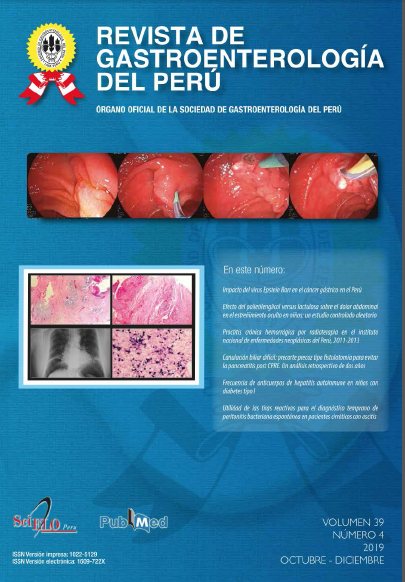Evaluation of frequency of autoimmune hepatitis autoantibodies in children with type 1 diabetes
DOI:
https://doi.org/10.47892/rgp.2019.394.997Keywords:
Antibodies, antinuclear, Autoantibodies, Autoimmune diseases, HepatitisAbstract
Background: Diabetes mellitus type 1 (T1DM) is one of the childhood diseases with growing prevalence. Various accompanying autoimmune diseases were seen with type 1 diabetes. The most common autoimmune diseases with T1DM are autoimmune thyroiditis and celiac disease. In some reports, autoimmune hepatitis has been reported in association with DM-1. Objectives: The aim of this study was to evaluate autoimmune hepatitis autoantibodies in children with T1DM. Materials and methods: In this crosssectional study, 202 children with T1DM were evaluated (47.5% were males and 52.5% were girls). Liver enzymes, autoimmune
hepatitis related autoantibodies such as anti-nuclear antibodies (ANA), anti-smooth muscle (ASMA) and anti liver and kidney microsomal antibodies (LKM-1) were measured. Liver ultrasound was done for participants and biopsy of liver was taken for children with increased echogenicity of the liver, hepatomegaly or elevated liver enzymes. Results analyzed by statistical software spss-16, Descriptive statistics and chi-square test, paired T-TEST. Level of less than 5% was considered statistically significant. Results: In 6 patients ANA and in 4 patients (2%) ASMA was positive,1 patient was ASMA positive but ANA negative. None of the patients were Anti LKM-1 positive. 3 patients had positive ANA and ASMA, and increased liver echogenicity on ultrasound simultaneously. Histological evaluation was showed that 2 patients had findings in favor of autoimmune hepatitis. Conclusion: Auto antibodies were positive in 10 cases. ANA was positive in 6 (2.97%) of all cases. ASMA was positive in 4 (1.98%) cases. Increased echogenicity was found in 3 cases. Histological evaluation showed 2 patients had biopsy confirmed autoimmune hepatitis. AIH-2 was not seen among our cases.
Downloads
Metrics
Downloads
Published
How to Cite
Issue
Section
License
Revista de Gastroenterología del Perú by Sociedad Peruana de Gastroenterología del Perú is licensed under a Licencia Creative Commons Atribución 4.0 Internacional..
Aquellos autores/as que tengan publicaciones con esta revista, aceptan los términos siguientes:
- Los autores/as conservarán sus derechos de autor y garantizarán a la revista el derecho de primera publicación de su obra, el cuál estará simultáneamente sujeto a la Licencia de reconocimiento de Creative Commons que permite a terceros compartir la obra siempre que se indique su autor y su primera publicación esta revista.
- Los autores/as podrán adoptar otros acuerdos de licencia no exclusiva de distribución de la versión de la obra publicada (p. ej.: depositarla en un archivo telemático institucional o publicarla en un volumen monográfico) siempre que se indique la publicación inicial en esta revista.
- Se permite y recomienda a los autores/as difundir su obra a través de Internet (p. ej.: en archivos telemáticos institucionales o en su página web) antes y durante el proceso de envío, lo cual puede producir intercambios interesantes y aumentar las citas de la obra publicada. (Véase El efecto del acceso abierto).

















 2022
2022 